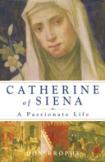Consumed by Inner Fire
Writers of saints’ lives must steer a careful course. Today’s readers generally bring a skeptical perspective to accounts of miracles, and they expect careful historical research to ground the narrative. At the same time, they expect, even hope for, some clear indication of exactly what makes this person a saint; they look for the numinous, tucked into the corners of historical reality. In Catherine of Siena: A Passionate Life, Don Brophy steers the course well. He benefits greatly from new access to all the saint’s writings—the letters, The Dialogue and her dictated prayers—which have recently become available in new translations and annotated editions.
From the opening pages, the reader is aware that Brophy is going to portray Catherine against the rich background of her social and historical context, the real world in which Catherine’s character took shape and in interaction with which she lived out her life. He says himself, in the author’s note at the end of the book, that his main focus is on Catherine’s public life rather than her interior life—though he never ignores or minimizes the importance of the latter—and he therefore shows us a Catherine who may surprise us.
Brophy begins by painting 14th-century Siena in broad brush strokes, reconstructing the social location that would shape Catherine’s perspective. Her early years were relatively uneventful; and her child’s piety seems, according to Brophy, appropriate in her own world. But at the age of about 6, she experienced a vision of Christ that shifted her focus and increased her intensity. Her first biographer, Raymond of Capua, gives the first account of this vision, and Brophy demonstrates its long-lasting effects on Catherine’s interior life. From the moment of her vision until she was 20, Catherine lived a life that followed the pattern of most medieval women saints: a single-minded pursuit of solitude and prayer, fasting to the point of destroying her health, a confrontation with her family and isolation from it.
In 1367 another vision turned Catherine’s life around once more. It was a vision in which Jesus espoused her to himself and called her, as she believed, to re-enter the life of the city of Siena. Her extraordinary public life was about to begin.
Brophy carefully lays out the competition among the various political factions that were at work in 14th-century Italy and Europe, much of it centered on the pope as a political as well as religious leader. He shows us a Catherine engaged in various missions for peace, for the restoration of the papacy to Rome and for the reform of ecclesiastical government itself, beginning with the appointment of bishops and cardinals. True to her time, Catherine believed in reform as primarily a matter of internal conversion and so, in addition to admonishing and persuading the pope and other powerful leaders, she began to preach.
From the earliest days of her public life, Catherine had gathered around her a large community of disciples, whose spiritual formation she undertook with fervor and enthusiasm. Her spiritual discourses with her disciples soon gave rise to letter-writing, and her voluminous correspondence, amply and judiciously cited by Brophy, shows her passion and her realism. Soon, too, her teaching took the form of public preaching; she became a skillful street preacher, and after her visit to the pope at Avignon, she gave herself more and more to this ministry. Finally, she began the book that would, she hoped, make her wisdom and experience available to a still wider audience. By the time of her death in Rome at age 33, Catherine was one of the most widely recognized public figures in Italy.
In spite of the visions, miracles and early ascetic practice, Brophy reveals a thoroughly human Catherine, fully a woman of her own day. He acknowledges, for instance, that in her missionary journeys for peace, she was as much driven by her own restlessness as by the will of God. She was relentless in seeking to found a monastery for her women followers, one that she can control, but could never remain there herself. He also deals honestly with much that remains problematic for the modern reader: the centrality of blood in her imagery and language, the violent cast of her thought. Granted that both these elements are part of the traditional metaphoric language of mysticism, they remain troubling, as does her desire to promote a new crusade to stop the Turkish advance in the Adriatic.
On the side of her saintliness, Brophy describes her ecstatic response to the Eucharist; the intimacy with which she spoke to and about the Lord; and the obvious spiritual influence she had upon all those she met, especially upon her community of disciples.
Yet I found myself wondering if the many popes who had promoted her cause, from Pius II in 1461 to John Paul II in 1999, had considered sufficiently what kind of woman they were recommending as a model. Catherine engaged in a public ministry, including public preaching, at a time when women were strictly relegated to the domestic sphere; she had the temerity to advise and even oppose the pope as well as the secular leaders of the Italian city states. Brophy gives us a portrait of a woman who was attentive to God’s presence at virtually every moment and affirms that Catherine consistently sought true self-knowledge. Because of this Catherine believed in herself and acted freely, in spite of convention, law and critical suspicion. She held to her convictions and pursued her own desires with a tenacity and assurance that, without her divine warrant, could easily be seen as arrogance. This is dangerous behavior indeed, but sanctity is not synonymous with safety. And Catherine, with her lifelong but unfulfilled desire to become a martyr, understood that better than most.
Told in vivid, felicitous language, Brophy’s biography reacquaints the reader with an extraordinary Christian.
This article also appeared in print, under the headline “Consumed by Inner Fire,” in the November 8, 2010, issue.








